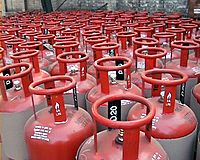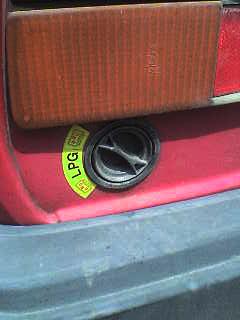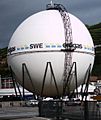Liquefied petroleum gas facts for kids
Liquefied petroleum gas (also known as LPG or LP Gas) is a mix of different hydrocarbon gases. It's a common fuel for many things, especially in homes. For example, people use it for cooking or to heat their houses. LPG is also becoming more popular because it's less harmful to the ozone layer than some older chemicals.
Often, LPG is sold as a mix of propane and butane gases.
Contents
What is LPG Used For?
LPG is used in many ways, especially in cylinders. These cylinders are great for storing fuel efficiently. You can find LPG being used in farming, for fun activities like camping, in restaurants, for heating, in construction, and even on boats. It's a good way to heat homes that aren't connected to a natural gas pipeline, and it can save money too.
Cooking with LPG
LPG is a popular cooking fuel in many countries. People choose it because it can be affordable, convenient, or simply because it's the fuel they prefer to use.
In India, a lot of LPG is used for cooking in homes. The government sometimes helps families pay for it. LPG was also a common cooking fuel in Hong Kong. However, as more buildings get town gas (another type of fuel), fewer homes use LPG. Still, in many villages and public housing areas, LPG stoves are the main option besides electric ones.
In Brazil, LPG is the most common cooking fuel in cities. Almost all homes use it, except in places like Rio de Janeiro and São Paulo, which have natural gas pipes. Families who don't have much money can even get a special government grant to help them buy LPG.
In North America, LPG is often used for cooking inside homes and for outdoor grilling.
Heating Homes in Rural Areas

In Europe and many rural areas around the world, LPG is a good choice for heating homes. It's often used where there isn't a natural gas pipeline. LPG can be an alternative to electric heating, heating oil, or kerosene.
LPG can also be used in special systems that create both electricity and heat from one fuel source. This means LPG can power not just heating and cooking, but also help make electricity for homes or small communities.
LPG can be stored in different ways. It can also be combined with renewable energy sources like solar or wind power. This helps make sure there's always power, even when the sun isn't shining or the wind isn't blowing. Unlike some renewable sources, LPG can work on its own without needing expensive battery storage for electricity.
Fuel for Vehicles
When LPG is used to power car engines, it's often called autogas. Some countries have used it as a fuel for cars since the 1940s. LPG is a good fuel because it's not harmful if it spills, it doesn't cause rust, and it doesn't have lead or other additives. It also has a high octane rating, which is good for engines.
LPG burns more cleanly than petrol (gasoline) or diesel. This means it produces fewer harmful particles when it burns. However, a car needs more LPG to go the same distance compared to petrol or diesel. Many governments make LPG cheaper by taxing it less than other fuels. This helps balance out the higher amount of fuel needed. Propane is the third most used car fuel in the world. In 2013, over 24.9 million vehicles worldwide ran on propane gas.
Not all car engines are suitable for LPG. LPG provides less lubrication for the top parts of the engine than petrol or diesel. This means engines might wear out faster if they aren't changed to work with LPG. However, many modern diesel engines can use LPG as an extra fuel alongside diesel.
Making Gasoline
LPG can be changed into a substance called alkylate. This is a great ingredient for making gasoline because it helps prevent engine knocking and burns very cleanly.
Refrigeration
LPG is also useful for keeping things cold, especially in places that don't have electricity. It's often used in special refrigerators called gas absorption refrigerators.
Some types of LPG, like pure propane or a mix of propane and isobutane, can be used as refrigerants. These are much better for the ozone layer and have a very low global warming potential compared to older refrigerants. They can replace older, more harmful chemicals used in fridges and air conditioners.
However, using flammable gases like these in car air conditioning systems is often not allowed. This is because there's a risk of fire or explosion if the system leaks. Even so, some people argue that such incidents are very rare compared to how many cars use these refrigerants.
Images for kids
-
A spherical gas container, often seen at refineries.
See also
 In Spanish: Gas licuado del petróleo para niños
In Spanish: Gas licuado del petróleo para niños









